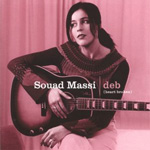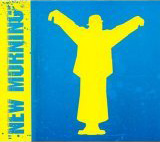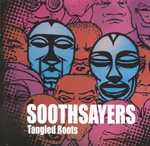Home » Jazz Articles » African Jazz » Cumulative Index of African Music CD Reviews
Cumulative Index of African Music CD Reviews
But upon the arrival of European colonists, everything changed. The occupying forces brought with them a new collection of traditions, ranging from church-derived choral music to marching bands and various other ensembles. Africans began to assimilate these sounds; traditional music was well along in giving way to popular music. And when jazz flooded America, it became a prominent cultural export to the African continent. So did the traditional forms of Cuba, Jamaica, the Antilles, Brazil and other areas. What resulted was a musical collision of epic proportions, which is still evolving in very unexpected and sometimes profound ways.
This page collects and archives individual reviews of African music which have been published as CD reviews at All About Jazz from 1998-2007. It excludes material reviewed elsewhere within the African Jazz column, as well as reviews of South African jazz, which have been archived separately.
- Prince Nico Mbarga, Aki Special (Rounder, 1997)
Nigerian star Prince Nico's 1977 record was his masterpiece, hugely popular all over the continent: tunes for dance and celebration. The big hit single celebrated motherhood, a revealing fact about Nico and his listeners.
- E.T. Mensah and the Tempos, All For You (RetroAfric, 1998)
The kind people at RetroAfric compiled 20 singles recorded by E.T. Mensah in the '50s. Mensah more or less invented highlife, a jazz-influenced style made popular in Ghana and exported to and developed in nearby regions, including most notably Nigeria. Highlife has remained a distinctive style ever since.
- Fela Anikulapo Kuti, Music is the Weapon of the Future (Exworks, 1998)
Out of Fela Kuti's immense discography, this disc is representative material. Fela is credited with the invention of Afrobeat—along with his essential drummer, Tony Allen—a broad synthesis of African drumming, jazz improvisation, and deep funk (among many other things).
- West African Highlife Band, Salute to the Highlife Pioneers (Inner Spirit Records, 1998)
Alumni from some of West Africa's greatest groups come together for a contemporary reinvention of highlife, a style which dates back a half century to roots in Ghana and Nigeria.
- Toumani Diabate with Ballake Sissoko, New Ancient Strings (Hannibal, 1999)
The kora, a 21-stringed harp-like instrument whose history dates back centuries, is featured here on a series of duets. These two masters bring traditional forms to life through delicate interaction and tasteful improvisation.
- Mor Thiam, Back to Africa (Justin Time, 1999)
Senegalese drummer Mor Thiam, who has spent some time working with the World Saxophone Quartet and Don Pullen, returned to Dakar to record this combination of pure drumming pieces and uplifting Afro-pop. Drumming, not surprisingly, lies at the core of nearly the entire album.
- Youssou N'Dour, Joko (The Link) (Nonesuch, 2000)
Afro-pop star Youssou N'Dour, the most popular and influential musician to come out of Senegal, conveys positive energy and an uplifting message. His mbalax style relies on a rich percussion section, lilting melodies, and his own distinctive voice.
- Asante, Ohene Kesee A Ebin (Wildchild/Mapleshade, 2000)
Asante, who comes from a family of drummers in Nigeria, made this recording at the sonically superior Mapleshade Studio in Maryland. In addition to a suite of pure drumming pieces (in which Asante "plays all five parts of the traditional African drum group" by himself), the drummer invites special guests on saxophone and piano to round out the recording.
- Various Artists, Nigeria 70: The Definitive Story of Funky Lagos (AfroStrut, 2001)
For listeners curious about what happened when funk collided with highlife, this set is the answer. AfroStrut put together over two hours of music representing key artists from '70s Nigeria, plus a documentary CD on the music with narrative, samples, interviews, and more. Absolutely priceless.
- Baaba Maal, Missing You (Mi Yeewnii) (Palm Pictures, 2001)
The masterpiece of Senegalese singer Baaba Maal's otherwise consistent output is extremely potent, cohesive and emotionally affecting. The most amazing thing about this record is that it was recorded in Maal's literal backyard, and the intimacy and chemistry of that setting comes through bright and clear on record.
- Master Musicians of Jajouka, Master Musicians of Jajouka Featuring Bachir Attar (Point Music, 2001)
A very unusual but effective combination of traditional Jajouka music from Morocco with modern electronic production by Talvin Singh, who worked with Bachir Attar for a decade before this recording was made.
- Antibalas Afrobeat Orchestra, Liberation Afrobeat Vol.1 (Ninja Tune, 2001)
The Antibalas Orchestra has taken the ideas of Afrobeat developed in Nigeria in the '70s and adapted them to a modern context. Clear debts to Afrobeat star Fela Kuti emerge through energetic, jazz-inflected funk with a political angle.
- Blo, Phases 1972-1982 (AfroStrut, 2001)
The trio known as Blo was born from the funk explosion in 1970s Nigeria. This retrospective covers their ten-year history, spanning a range of music from psychedelic sounds through heavy funk and fresh disco. There's no doubt at any point where these guys are from.
- Fela Ransome-Kuti with Africa 70, Fela With Ginger Baker Live! (FAK/MCA, 1971/2001)
Fela Kuti's music brought together a global spectrum of sound. This recording, made shortly after Kuti returned to Africa from the United States, feaures Cream drummer Ginger Baker as guest artist. Tasty tunes, tight band, liquid flow.
- Master Fiddlers of Dagbon, Master Fiddlers of Dagbon (Rounder, 2001)
John Miller Chernoff, an anthropologist, sociologist and musician, assumed a valuable role as documentary historian when he produced this recording of a traditional fiddle performance from the Dagbon people of northern Ghana. The dominant instrument, a one-string violin, makes a tremendous impact at a visceral level.
- Frank Tenaille, Music Is The Weapon of the Future: 50 Years of African Popular Music (Lawrence Hill Books, 2002)
In this excellent book, Tenaille examines influential musicians from all over the African continent. He provides information about distinctive styles, history and influences, and essential recordings representing a huge variety of approaches. A fine introduction and a valuable reference.
- Badenya, Manden Jaliya in New York City (Smithsonian Folkways, 2002)
Badenya is an active group of musicians in NYC who play pieces drawing from the traditions of the Ancient Empire of Mali. Spare and open, this music sounds timeless and contemporary all at once.
- Orchestra Baobab, Specialist in All Styles (World Circuit, 2002)
Twenty years after reigning supreme as the most popular band in Senegal, Orchestra Baobab reformed to record this mellow, attractive collection of Afro-Cuban music, including a version of the classic "El Son Te Llama."
- Antibalas, Talkatif (Ninja Tune, 2002)
A worthy followup to Liberation Afrobeat, this funky, jazzy record recalls the heyday of Fela Kuti's Afrobeat, especially in the interlocking rhythms, which keep the groove rock-solid and allow the other instrumentalists to soar.
- Bembeya Jazz, Bembeya (Marabi/World Village, 2003)
Another comeback album, this time by a band with decades of history and popularity in West Africa. Guinea's Bembeya Jazz, a twelve-piece group dominated by horns, vocals and guitars, recalls the golden era and provides a strong call to dance. Griot guitarist Sekou Diamond Fingers Diabaté is largely responsible for the mood and style of the music.
- Souad Massi, Deb (Heart Broken) (Wrasse, 2003)
Souad Massi has made significant strides since she left Algeria for Paris, and this, her second release, comes across in a personal, sincere, honest way—revealing the melancholy and romance of her world and a variety of influences that have crisscrossed the Western Mediterranean over time.
- Abdoulaye N'Diaye, Taoué (Justin Time, 2003)
With the help of David Murray, a true veteran of multicultural embrace, Senegalese saxophonist Abdoulaye N'Diaye makes his debut a combination of African-American jazz and instrumentation with West African traditions and instruments like the kora and djembe.
- Issa Bagayogo, Tassoumakan (Six Degrees, 2004)
By making use of modern production tools, Malian singer and ngoni player Issa Bagayogo tweaks ancient musical traditions and instruments to yield a modern, affable, groovy mix.
- Ali Farka Toure, Red & Green (Nonesuch, 2005)
This attractively packaged double-disc set reissues two albums that Malian master blues guitarist Ali Farka Toure made in the early '80s. It's a fine complement to the rest of his output, especially in the way it reveals the raw roots which newcomers to his music may not yet have discovered.
- Oliver Mtukudzi, Nhava (Heads Up, 2005)
Along with Thomas Mapfumo, Oliver "Tuku" Mtukudzi has kept the flame of traditional Shona music from Zimbabwe alive by creating fertile hybrids with other southern African idioms, as well as modern instruments and styles. Very accessible, but unpretentiously deep at the same time.
- Konono No.1, Congotronics (Crammed Discs, 2005)
Mad Max mutant roots from the dirt poor Kinshasa suburbs. Crudely and heavily amplified bass, tenor, and treble likembes (thumb pianos); scrap metal drums and percussion; and sonic distortions which, accidentally but wonderfully, lend the music the character of Western heavy-electronica.
- Ayetoro, Omo Obokun: The Afrobeat Chronicles Vol. 2 / Directions In Music By Funsho Ogundipe (Flying Monkeys, 2006)
Something other than the straightline Afrobeat suggested by the title is abroad here, but once you've recalibrated your expectations, you'll likely find it enchanting and distinctly more-ish. It's Afrobeat alright, but cooked in a gentler oven and spiced with subtler ingredients than in Fela Kuti's recipes.
- Papa Wemba, New Morning (Synchronies Music, 2006)
Number one with a mango. Recorded live in Paris, gorgeous small band arrangements of some of Papa Wemba's best-loved hits of the '90s and early '00s—irresistible body-rocking Congolese rumba/ soukous with a dash of salsa and two dashes of French pop. The accompanying DVD is an audio-visual treat.
- Solomon Ilori And His Afro-Drum Ensemble, African High Life (Blue Note, 2006)
Every now and again, a label pulls an unissued session out of the vaults and it proves to be a down-by-law, certified stoner. The original palmwine highlife album recorded in the US in '63/'64 by Nigerian expat Ilori is augmented here by three previously unreleased, extended drum choir workouts featuring guests including drummer Elvin Jones and trumpeter Donald Byrd.
- Tony Allen, Lagos No Shaking (Honest Jons, 2006)
Longtime Fela Kuti mainman Tony Allen's drumming continues to delight, but the album overall, like other post-Kuti Allen albums before it, is a mixture of the sublime and the frankly pretty ordinary, with on this occasion rather too much of the latter.
- Various Artists, Lagos Chop Up (Honest Jons, 2006)
An inspired trawl through the treasure trove that is urban Nigerian social music of the late '60s through mid '80s—a laid-back, all-night, intertribal dance party featuring classic highlife, Afrobeat, juju, and fuji hits of the era in all their four-track, one-take, original glory.
- Soothsayers, Tangled Roots (Red Earth, 2006)
A five-star, in-the-tradition, establishment-challenging, all nations Afrobeat monster out of London. Part of Soothsayers' genius has been to retain the raw simplicity and drive of Fela Kuti's original creation, while grafting on some of the most beautiful black and African musics that have since coexisted alongside it, including most prominently conscious reggae, dub, mbalax, jonkonu, funk, hip-hop and jazz.
- Various Artists, Congotronics 2 (Crammed Discs, 2006)
A fresh serving of mesmerising trance music from Kinshasa, served up with a little more variety than on Konono No.1's original, apocalyptic Congotronics. Subtitled Buzz 'n' Rumble From The Urb 'n' Jungle, this excellent second edition features Konono alongside six other Kinshasa mutant roots bands.
- Ismael Lo, Senegal (Universal Music France, 2006)
The first album of new material by "Africa's Bob Dylan" in over five years, incorporates vaguely North African and vaguely South African elements here and there—appealing gestures, with high production values to boot, but more of a murky international pop stew than the genuine cross-cultural fusion of his Senegalese compatriots Youssou N'Dour and Thione Seck.
- Super Rail Band Of The Buffet Hotel De La Gare De Bamako, Super Rail Band (aka New Dimensions In Rail Culture) (GlobeStyle, 2006)
The Super Rail Band was a vital early career stepping-stone for band members Salif Keita and Mory Kante. Recorded in late '82 and first released in the UK in '85 as New Dimensions In Rail Culture, this reissue puts an important piece of the electric griot jigsaw back in the racks.
- Maurice El Medioni meets Roberto Rodriguez, Descarga Oriental: The New York Sessions (Piranha, 2006)
The less-traveled byways of cross-cultural exploration sometimes reveal the most fascinating new horizons, and this meld of Cuban and Algerian musics is an example. Cuban-born, New York-resident percussionist Roberto Rodriguez meets Marseilles-based, Algerian pianist Maurice El Médioni at the grass roots of Andalusian music, and a rainbow-hued romp of a party breaks out.
- Extra Golden, Ok-Oyot System (Thrill Jockey, 2006)
Pure guitar pleasure, as Washington, DC indie rock band Golden record with Kenyan benga master Otieno Jagwasi. "Ok-oyot" apparently translates as "it's not easy," a catchphrase employed by benga musicians to refer to the burdens of everyday life—but it could equally apply to the deceptive ease of the complex music they produce. Otieno's guitar and voice allow both interpretations.
- Babatunde Olatunji, Circle of Drums (Chesky, 2006)
A posthumous release by longtime expatriate, percussionist and world-music impresario Olatunji offers contemplative drum concertos. The very names of the drums are evocative—ashiko, djembe, ngoma, gudugudu, shekere—but they are sonically heterogeneous as well: the mix of metal, wood, animal hide and other materials provides considerable variation in pitch and timbre.

< Previous
Harbor
Next >
One Summer In Winters
Comments
About Various Artists
Instrument: Various
Related Articles | Concerts | Albums | Photos | Similar ToTags
Concerts
For the Love of Jazz
 All About Jazz has been a pillar of jazz since 1995, championing it as an art form and, more importantly, supporting the musicians who create it. Our enduring commitment has made "AAJ" one of the most culturally important websites of its kind, read by hundreds of thousands of fans, musicians and industry figures every month.
All About Jazz has been a pillar of jazz since 1995, championing it as an art form and, more importantly, supporting the musicians who create it. Our enduring commitment has made "AAJ" one of the most culturally important websites of its kind, read by hundreds of thousands of fans, musicians and industry figures every month.




























